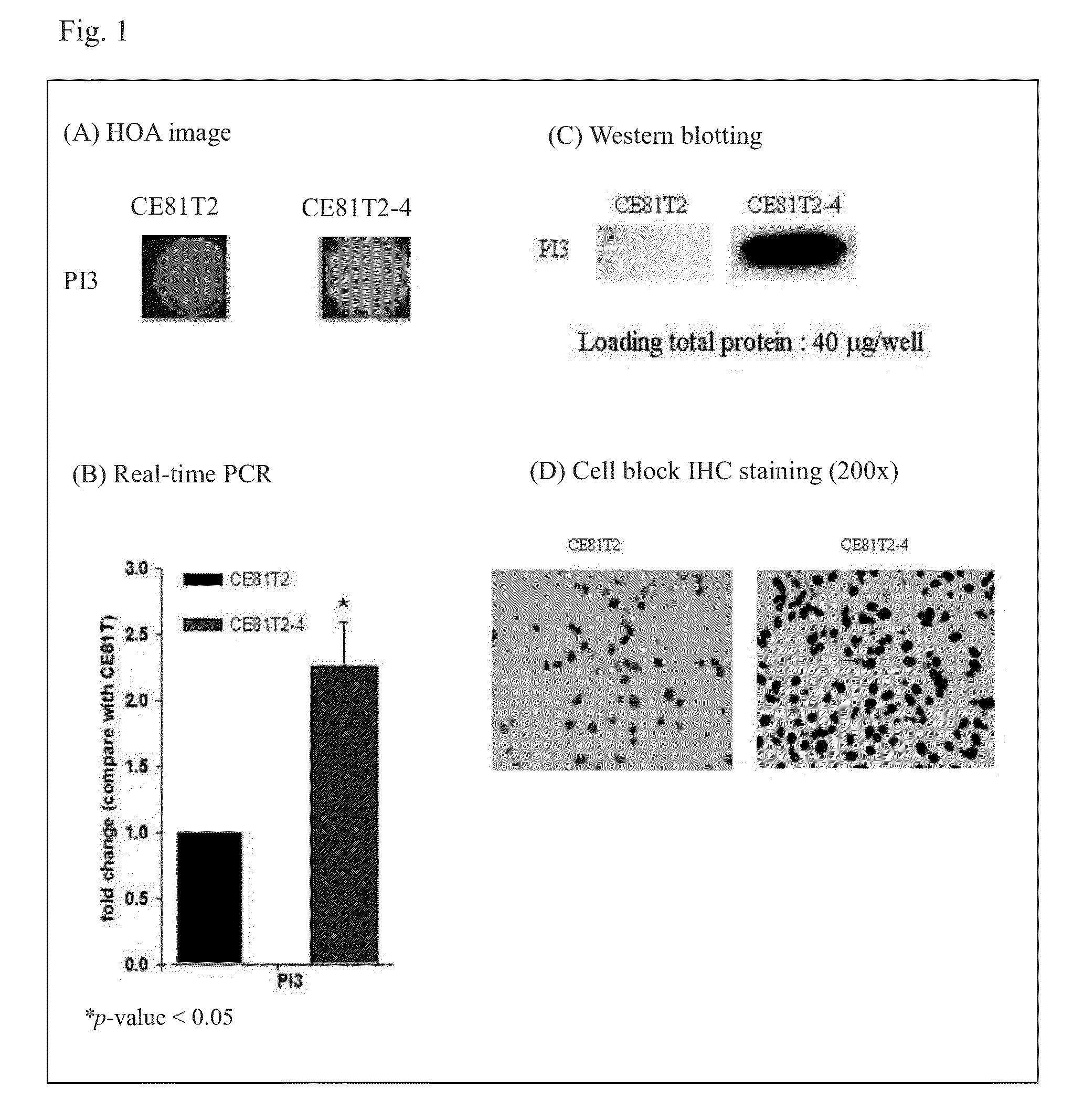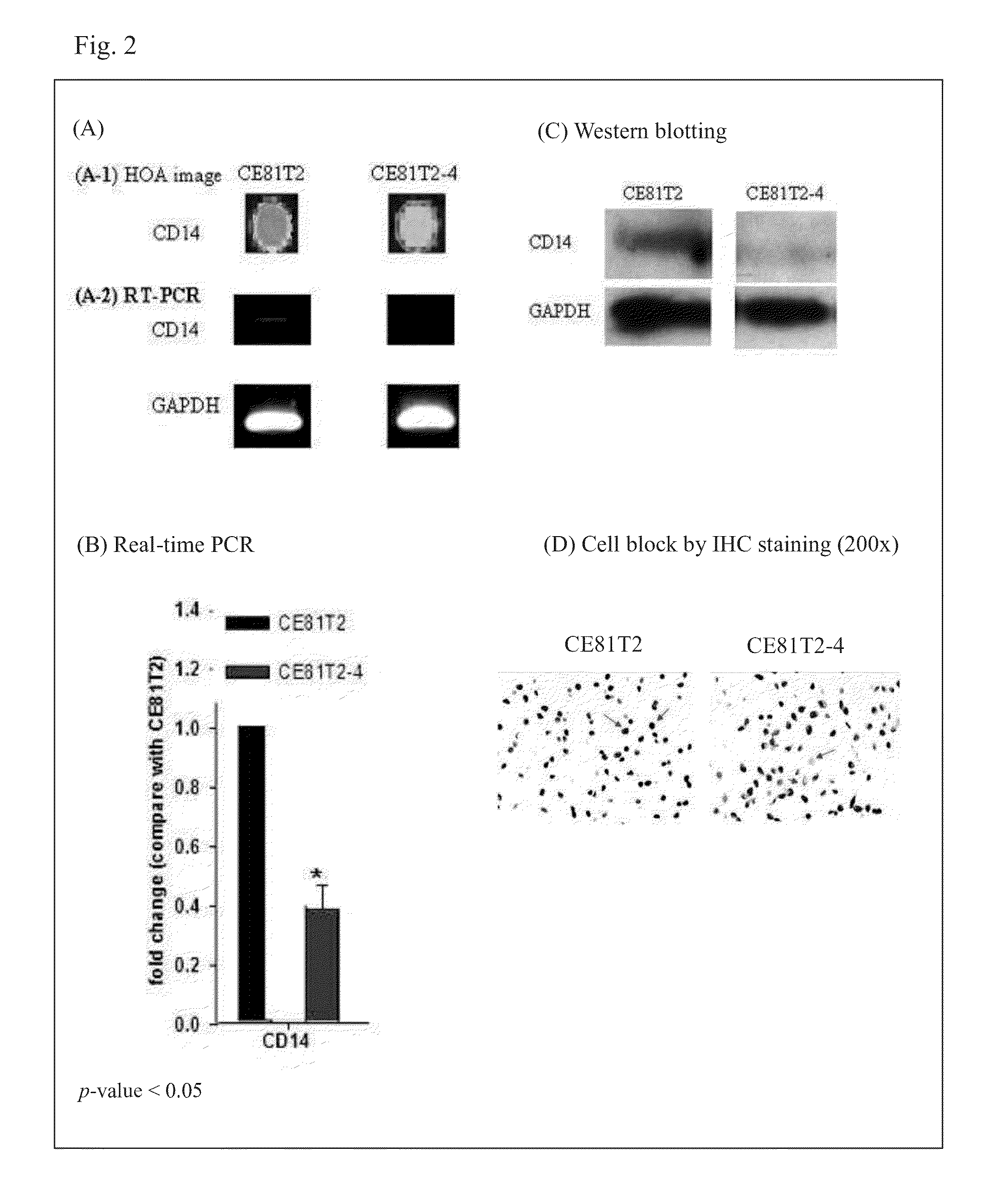Method for predicting the survival status and prognosis of esophageal cancer and a kit thereof
a technology for esophageal cancer and survival status, which is applied in the field of methods for predicting the survival status and prognosis of esophageal cancer, can solve the problems of nausea, vomiting and regurgitation, and difficulty in swallowing hard and solid food (e.g. bread or meat), and achieves the effects of reducing the risk of esophageal cancer survival, and improving the survival ra
- Summary
- Abstract
- Description
- Claims
- Application Information
AI Technical Summary
Benefits of technology
Problems solved by technology
Method used
Image
Examples
example 1
Detecting the RNA Expression of PI3 and CD14 by Real-Time PCR
[0037]As showed in FIG. 1, PI3 gene was strongly expressed in cell line ESCC CE81T2-4, but PI3 gene was no or weakly expressed in CE81T2. In addition, as showed in FIG. 2(A-1), the signal expression of CD14 was higher in CE81T2 than in CE81T2-4. Then the present invention used real-time PCR to quantify RNA expression levels of PI3 and CD14 in CE81T2 and CE81T2-4.
[0038]Total RNA from cell lines was extracted, and then reverse transcribed to cDNA. After reverse transcription, 300 ng cDNA was mixed with 1×SYBR Green Master Mix (Roche Cat; NO. 03 531 295 001) and 10 mM primers (the primer sequences are showed in Table 2 and SEQ ID NO. 1˜4), and the real-time PCR was performed. The present invention evaluated PI3, CD14 and glyceraldehydes-3-phosphate dehydrogenase (GADPH) expressions by real-time PCR.
[0039]Quantitative real-time PCR was performed using an ABI STEP-ONE REAL-TIME PCR SYSTEM® (Applied Biosystems).
[0040]Amplificati...
example 2
Detecting the Protein Level of PI3 and CD14 by Western Blotting
[0042]The present invention used Western blotting to examine PI3 and CD14 protein expression levels in CE81T2 and CE81T2-4. The experimental method as following: Cells for detecting CD14 protein were collected and extracted by using lysis buffer (150 mmol / L NaCl, 0.1% sodium dodecyl sulfate, 10 mmol / L EDTA, and 1% NP40, 1× protease inhibitor (Roche) and 50 mmol / L Tris-HCl (pH 7.5); and cells for detecting PI3 protein were collected and extracted by using the trichloroacetic acid (TCA) precipitation method.
[0043]After the total protein was extracted by above methods, the present invention used BCA protein assay (Pierce) to determine the protein concentration. Protein samples were mixed 1×SDS protein loading buffer (Invitrogen) and heated at 70° C. for 10 minutes. After that, equal amounts of protein (40 μg) were separated on 4-12% gradient acrylamide gel (Invitrogen). After electrophoresis, the protein samples were transf...
example 3
[0046]Detecting the Protein Expression of PI3 and CD14 by the Immunohistochemistry (IHC)
[0047]The present invention provided a method of detecting the protein expression in CE81T2 and CE81T2-4 by immunohistochemistry (IHC). These results were similar as mentioned above.
[0048]The present invention used same antibodies to perform IHC and Western blotting (FIG. 1D and FIG. 2D), that was, anti-CD14 rabbit polyclonal antibody (sc-58954, SantaCruz) and anti-PI3 rabbit polyclonal antibody (sc-20637, SantaCruz). As FIG. 1D showed, PI3 protein expressed was higher in CE81T2-4, and FIG. 2D showed that CD14 protein level in CE81T2-4 was lower than CE81T2.
[0049]Summarizing the results, as FIG. 1D and FIG. 2D showed, PI3 expression level was high and CD14 expression level was low in CE81T2-4 cell line. However, PI3 expression level was low but CD14 expressed was high in CE81T2 cell line. As the description above, due to CE81T2-4 was more malignant than CE81T2, CE81T2-4 belonged to low survival r...
PUM
| Property | Measurement | Unit |
|---|---|---|
| thick | aaaaa | aaaaa |
| temperature | aaaaa | aaaaa |
| temperature | aaaaa | aaaaa |
Abstract
Description
Claims
Application Information
 Login to View More
Login to View More - R&D
- Intellectual Property
- Life Sciences
- Materials
- Tech Scout
- Unparalleled Data Quality
- Higher Quality Content
- 60% Fewer Hallucinations
Browse by: Latest US Patents, China's latest patents, Technical Efficacy Thesaurus, Application Domain, Technology Topic, Popular Technical Reports.
© 2025 PatSnap. All rights reserved.Legal|Privacy policy|Modern Slavery Act Transparency Statement|Sitemap|About US| Contact US: help@patsnap.com



